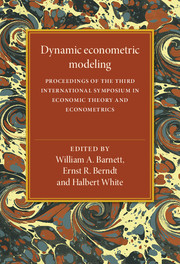 Dynamic Econometric Modeling
Dynamic Econometric Modeling Book contents
- Frontmatter
- Contents
- Editors' introduction
- List of contributors
- Part I Dynamic structural modeling
- Part II Linear time series modeling
- Part III Chaotic attractor modeling
- Part IV Applications
- 13 Investment and sales: some empirical evidence
- 14 Me and my shadow: estimating the size of the U.S. hidden economy from time series data
- 15 Estimating structural models of unemployment and job duration
16 - Comparison of dynamic factor demand models
Published online by Cambridge University Press: 03 May 2010
- Frontmatter
- Contents
- Editors' introduction
- List of contributors
- Part I Dynamic structural modeling
- Part II Linear time series modeling
- Part III Chaotic attractor modeling
- Part IV Applications
- 13 Investment and sales: some empirical evidence
- 14 Me and my shadow: estimating the size of the U.S. hidden economy from time series data
- 15 Estimating structural models of unemployment and job duration
Summary
Introduction
In order to explain the cyclical behavior of investment, the single–period neoclassical model of the firm has been revised to include nonlinear and time–dependent investment good production technologies. It has been observed that the shadow price of capital varies considerably over the business cycle and that the price of investment goods differs substantially from measures of the shadow price of capital. These macroeconomic phenomena have prompted modification of the model of the firm to include costs of adjustment of the capital stock and capital stock vintage effects. Both the cost–of–adjustment approach as proposed by Lucas (1967) and the vintage model [the “time–to–build” approach of Kydland and Prescott (1982)] give rise to a system of dynamic factor demands that allow for a richer class of investment behavior than static models. The object of this chapter is to examine the competing vintage and cost–of–adjustment models using U.S. production data. A new statistical methodology for choosing among nonnested models of optimizing behavior is developed and applied to this critical investment problem.
Empirical work on the derived demand for capital and other factors of production has focused on one–period models of the firm. A wide variety of functional forms have been proposed for production and cost functions. The translog form [see Berndt and Wood (1975) for production applications], the miniflex Laurent form proposed by Barnett (1983), and the Fourier flexible form proposed by Gallant (1982) have all been applied within the context of static models of the firm.
- Type
- Chapter
- Information
- Dynamic Econometric ModelingProceedings of the Third International Symposium in Economic Theory and Econometrics, pp. 357 - 376Publisher: Cambridge University PressPrint publication year: 1988
- 5
- Cited by
